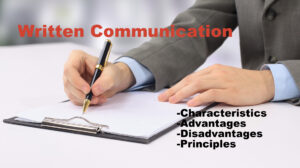Written Communication
Written communication is the most common form of business communication. Speech came before writing. But writing is more unique and formal than speech. Effective writing involves careful choice of words, their organization in correct order in sentences formation as well as cohesive composition of sentences. Also, writing is more valid and reliable than speech. But while speech is spontaneous, writing causes delay and takes time as feedback is not immediate. It is essential for small business owners and managers to develop effective written communication skills and to encourage the same in all employees.A written communication in an organization can be in the form of instructions,letter,memos,formal reports,rules and regulations,policy manuals,information bulletins etc.
Characteristics of Written Communication
1. Most formal type of Communication
Usually most of the informal, casual conversation or friendly conversation is done orally. Whenever there is need for formal communication, it is the written mode that is preferred.
2. Used for documentation
Written communication is mostly used for documentation. In an organization, documentation of records and decisions made from time to time are very important for which written communication comes handy.Written Communication acts as a permanent record of the organization and can prove very useful for future reference. For instance, previous orders and decision can serve as guidelines for future decision. Previous years’ reports are fund beneficial for formulating new polices and fixing current targets. The content of written communication is accepted as evidence in case of any litigation.
3. Used for circulation of information
This is used for circulation of information in the organization. Written communication makes it possible to circulate information without distortions an d misrepresentations.
4. Conventional by nature
There are not many rules of grammar for oral communication, as there are for written communication. Written communication is conventional in the sense that it has to follow definite pattern as per rules laid down by the language.
5. Presence of both sender and receiver is not necessary at the same time.
It is an important feature of written communication where the presence of just the sender or the receiver is sufficient at a given point in time, to continue the process of communication.
6. Time factor
The sender takes his own time in formulating the message which in turn takes quite some time to reach the receiver .The receive will take his own time in filtering it through his mind and responding to it.
7. It has fewer cycles
Usually the message is sent and received and that is the end of event. Of course, letters do lead to repeated cycles or communication exchanges. But they cannot compare with the quick succession of cycles involved involved in a dialogue or informal meeting.
8. A creative activity
Written communication is a creative activity that requires a lot of imagination and effort to arrive at the finished product. While oral communication is spontaneous, written communication is based on conscious effort.
Advantages of Written Communication
1. Written communication helps in laying down apparent principles, policies and rules for running of an organization.
2. It serves as evidence of events and proceedings.
3. It is a permanent means of communication.The message can be stores for an indefinite period of time.
4. It reduces the likelihood of misunderstanding and misinterpretation.This is because,generally people are more careful with written word than the spoken word. Thus the written communications are more likely to be well considered,logical and clear.And the message can be checked for accuracy before it is transmitted.
5. It is more reliable for transmitting lengthy statistical data.
6. It appears formal and authoritative for action.
7. It assists in proper delegation of responsibilities.While in case of oral communication,it is impossible to fix and delegate responsibilities on the ground of speech as it can be taken back by the speaker or he may refuse to acknowledge.
8. Effective written communication develops and enhances an organization’s image.
[adinserter name=”Block 1″]




Nice material it helps me very much???